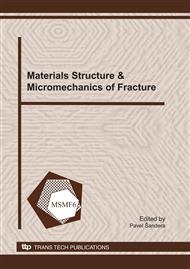p.543
p.548
p.552
p.556
p.560
p.564
p.568
p.574
p.578
Crack Behaviour in Polymeric Composites: The Influence of Particle Shape
Abstract:
In this paper polymeric particulate composites are studied (especially polypropylene (PP) matrix stuffed by rigid mineral fillers). Presently, polymeric particulate composites are frequently used in many engineering applications. The composite was modeled as a three-phase continuum – matrix, interphase and particle. The properties of the particles (size, shape) have a significant effect on the global behaviour of the composite. On the basis of fracture mechanics methodology the interaction of micro-crack propagation in the matrix filled by rigid particles covered by the interphase was analyzed. The effect of the composite structure on their mechanical properties is studied here from the theoretical point of view.
Info:
Periodical:
Pages:
564-567
Citation:
Online since:
January 2011
Authors:
Price:
Сopyright:
© 2011 Trans Tech Publications Ltd. All Rights Reserved
Share:
Citation:


